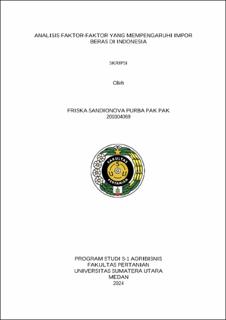| dc.description.abstract | Rice is a staple food for most Indonesians and the availability of rice is crucial to maintaining food security. Indonesia's rice production is sufficient to meet the rice consumption needs of the Indonesian people. However, what happens is that Indonesia continues to import a large amount, reaching 3 million tons in 2023. This is the problem to be investigated in this research. The aim of this study is to determine the development of factors that affect rice imports such as land area, rice production, rice consumption, IDR/USD exchange rate, Indonesian GDP and local rice prices and to find out how these factors affect rice imports in Indonesia. The analysis method used is descriptive method and Autoregressive Distributed Lag (ARDL) model. The data used is time series data for the period 1993-2023. The results showed that the development of rice imports, harvest areas, rice production, rice consumption, GDP, exchange rates, and local rice prices during the period 1993-2023 fluctuated greatly. In the long term and short term, the variables of harvest area, consumption, GDP, and local rice price have a positive effect on rice imports. Meanwhile, production and exchange rate variables negatively affect the volume of rice imports. | en_US |


